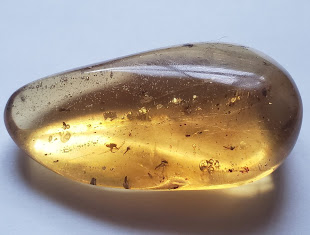Is Your Amber Real?
Is Your Amber Real?
How To Identify Faux Amber From Real Amber
Before we can talk about identifying real and fake amber, we have to know what amber is in the first place. Amber is fossilized tree resin, which became a fossil after millions of years. Amber can come in different colors and shades, and some even have some inclusions.
 |
| My piece of amber with insect inclusions |
Identifying Real Amber From Faux Amber
So, you bought a piece of amber, and don't know if it's fabricated? There are 3 main ways to tell if your amber is real. The first one is the Static Test. Take your piece of amber, and rub it in a cloth for roughly thirty seconds. Immediately but the amber up to your hair, or a small piece of paper. Does it "pick up" the hair/paper? If so, your piece has passed the first test! Well, what if there wasn't static?
 |
| What I believe to be an ancient mosquito in my amber specimen |
This could mean one of two things. First, it could mean that you didn't do the test right. Second, it could mean that your amber is not real. Test two involves heating up a small needlepoint and poking your amber. I would not recommend doing this on a small piece, expensive piece, or bead. Does the amber melt and produce cracks? Does it smell sweet? If yes to both, your piece has passed the second test. If the needle went through quickly and produced a plastic or pine smell, it is most likely Copal. Again, I do not
 |
| My phone camera doesn't do my amber specimen much justice, but I can confirm that it looks much more fluorescent in person. |
recommend doing this to a small, or a very nice and expensive piece of amber. The third, and final test is the UV test. If you take your amber specimen into a dark room and shine a UV light on it, it should fluoresce a nice green color. If it did, you almost certainly have a genuine piece of amber! If your piece does not give off a green color, then I'm afraid it is not actually amber. You may be wondering, "If it's not amber, then what could it be?"
Faux Ambers
So, your "amber" failed the tests. There are many different types of fake ambers, but the main one is usually Copal. In a nutshell, Copal are immature amber. Theyre made of resin that have not fully developed, and they can have insects purposefully placed, or just naturally trapped inside of them.
 |
| A piece of Copal with included insects |
Many stores, online and in physical locations toss around the word amber, and they can sell you a fake piece without even knowing. So please be careful when buying amber, as it is starting to become rarer, which in turn makes it even more expensive. Most stores should be able to tell you why their amber is real, and not fake.



Comments
Post a Comment